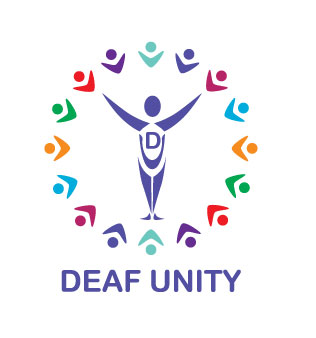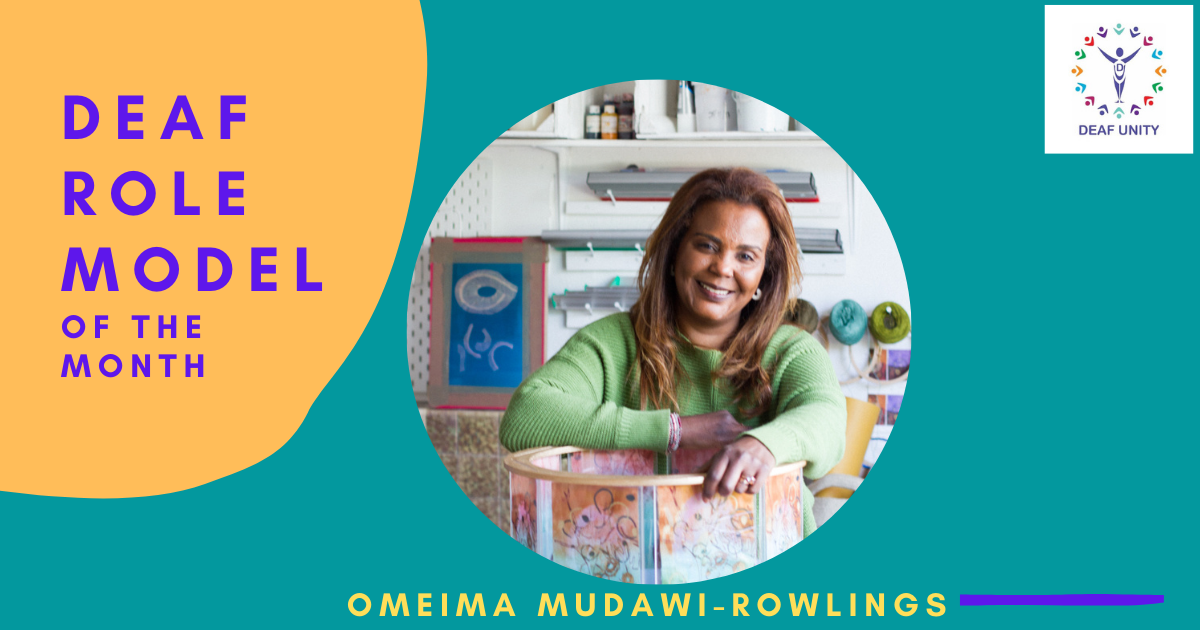 Each month we invite an inspirational or outstanding deaf role model to share their story. From what they’ve learnt, to what they wish they’d have known and their best deaf tips.
Each month we invite an inspirational or outstanding deaf role model to share their story. From what they’ve learnt, to what they wish they’d have known and their best deaf tips.
Our role model this month is Omeima Mudawi-Rowlings – a creative trailblazer who has pushed through barriers to pave the way for others to follow.
1. Please tell us a little about yourself?
I am British-Sudanese and became deaf when I was 4 years old, living in Khartoum until the age of 12. At that time, also having a brother who became deaf, I moved to the UK, as my family realised we would have better educational and life choices here. It was a time of huge upheaval, with my father remaining in Sudan to finance us (myself, my mother and brothers and sisters), and the family using both Arabic and English to communicate, whilst my brother and I began to use BSL.
Eventually I undertook a BA in Textile Design at the Surrey Institute for Art and Design, University College (now the University for the Creative Arts) in Farnham; I learnt a lot here but after graduating I came up against a wall, unable to find accessible opportunities in the craft world.
My creative plans were shelved, and instead I took a job as an ethnic minority worker and development officer at Friends for Young Deaf People. This was followed over the years with various roles supporting vulnerable and marginalised deaf people in cultural and social welfare settings, and to support my creative side I was a freelance creative consultant working to make mainstream arts more open and accessible to deaf participants. When I could, I continued to make small artworks and founded the deaf women artist group Resonant with other deaf creatives to support our art practices and try to be seen and heard!
I went on to study for an MA in Arts Policy and Management at Birkbeck, University of London. Through Resonant, I worked in partnership with Shape Arts and SPACE, before eventually landing a studio space with Cockpit Arts, for which I’d previously applied without success.
It was at Cockpit Arts that I set up my own business, Omeima Arts, combining textile making and art projects with creative consultancy working with deaf /disabled artists, advocacy and deaf awareness training.
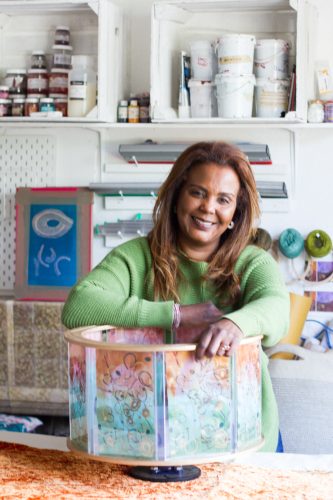
2. Did you grow up in the Deaf Community or come to it later in life?
There were no deaf schools in Khartoum when I was growing up, and Arabic was my first language although we also learnt English. I never met anyone else who couldn’t hear; there was no community of deaf people, and my teachers didn’t really get that I was deaf, especially when I changed schools. Attitudes have improved now, with two deaf schools in Khartoum – and Sudanese sign language has a lot in common with the American version.
When I moved to the UK my education was in in an oral deaf setting, and I had limited contact with BSL. This began to change as my deaf brother became a passionate and fluent signer and helped me to learn BSL. He had very strong links to the deaf community and this was another influence on me.
3. What was your experience of education as a deaf person?
Generally it was very tiring, frustrating and a struggle- both in school and higher education (in a mainstream setting). It was only later, when the equality laws in the UK had forced positive change in the ways deaf and disabled people get support, that I began to experience fairer and more equal access to education. This was during my MA in Arts Policy and Management at Birkbeck: the first time I had a note taker, language support and interpreters. What a huge difference this made! I could actually learn without juggling so many tasks and having my concentration and energy divided. Anyone who thinks access is not important has never been in need of it!
4. Do you feel that deaf people have a special perspective on a visual medium like art?
Yes definitely, in my view. We engage with visual interpretation all the time and it is a natural medium for our creativity to grow in.
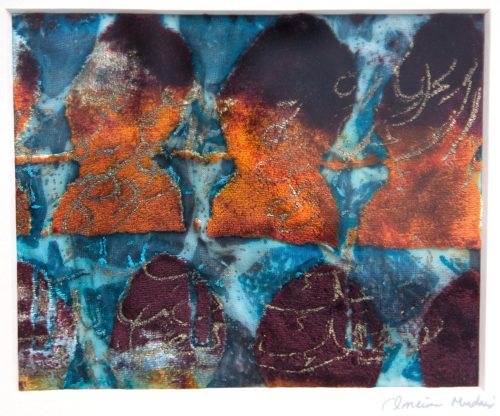
5. Have you found the Creative and Art World to be welcoming and accessible to a deaf person like yourself?
This is mixed. I mentioned that deaf people can have a natural connection with visual mediums, but the ‘art world’ creates huge barriers around language for example, meaning that deaf artists struggle to connect with it and also to have their work (as well as themselves) understood. There is a lot of paperwork and bureaucracy in the arts, from applying for funding, running projects, maintaining a studio, applying for opportunities … so much of it is like a maze and inaccessible without language and communication support. While many things have improved, I worry that creative organisations are afraid of deaf people being a burden on them, in terms of resources, time and establishing relationships. My aim is for deaf and hearing people to be better integrated through creativity, so hopefully I can be part of the change that is needed.
6. How would you like to see deaf creatives showcased more thoughtfully or more widely?
On balance, in spite of the negative things about social media, platforms like Instagram are a great, and very visual, way of sharing art and creativity. It means we can share and influence people without relying on words or written statements.
I have noticed more use of video-based formats for interviews and discussion, and this (provided there is captioning and signing) gives deaf people and people who are hard of hearing a much more equal chance to enjoy culture as well as take part in it and show what they can do. We have a more visual language today with stickers, emojis and so on, so I am sure that the way younger (deaf) people naturally communicate online (and share their art and creativity) will be more effective than what my own generation were using.
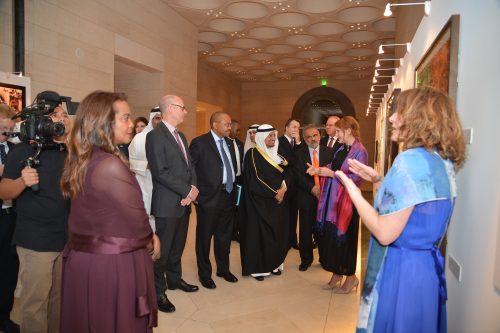
7. You were recently awarded an MBE – congratulations – could you tell us a little bit about that and how it feels to be recognised in such a way?
Honestly, I was astonished and quite overwhelmed, it was the last thing I was expecting to be contacted about. Apart from the initial shock, I kept wondering who on earth had nominated me … and why …? But it was also a happy feeling … it’s great to be recognised, and when I look back at how many years I have been practising as an artist and trying to bring deaf and hearing creatives into an equal space, I felt it was great to have this acknowledge by those I had been working with.

8. Who inspires you and why?
I am always inspired by people who help improve others’ lives whilst achieving something – whether they meant to help others to begin with, or not. Frieda Kahlo is a great example of that- I love her art, and the profile she has given women artists- she has become an icon and a powerful role model for many disabled and marginalised people as a result of her skills, style and personality.
9. What ways do you think hearing people can be allies to the deaf community? Any DOs and DON’Ts?
I mentioned the use of video/ visual media before, and I would urge hearing/ mainstream organisations to allow BSL submissions and video-based formats for when deaf people apply for opportunities, grants, jobs etc. And to ALWAYS use captions in the videos and films they make or exhibit. They should seek out opportunities to include BSL and BSL users in their programmes- don’t just provide sign language support as a last minute thing for guests. Involve us, ask us what we want, what we think; ask to see our work!
Being flexible in their means of communication is the key to us all making progress together. I am happy to work with organisations to make this happen!
10. Top tips for deaf people?
I would simply say: Follow your passion, keep focussed on your dreams and don’t give up, no matter what life throws at you. You will eventually find your way.
Be courageous, build resilience, and reach out to others- you don’t have to always go it alone.
Check out Omeima’s work on: Instragram & Twitter at ‘Omeima Arts’; and Facebook at ‘Omeima Mudawi-Rowlings’.
Looking for more support? We’ve made it our mission to improve the lives of deaf people everywhere. Check out Deaf Unity’s projects to find out what we can do for you. If you’d like to get in touch, contact us here.

